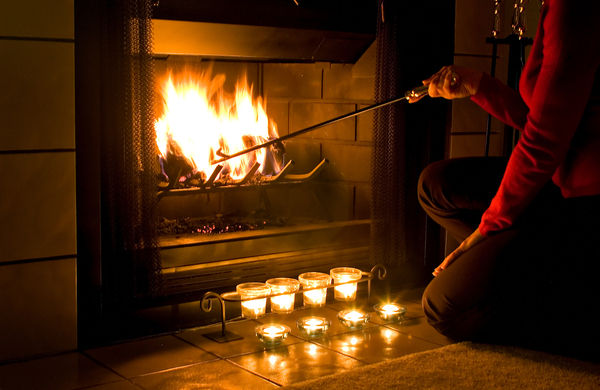Anyone who has ever tried, failed, and tried again to light a warm and cozy fire at home knows there’s more to it than some kindling and matches. Smoke doesn’t just billow up any old path between a fireplace and the roof. There’s science behind good chimney draft that minimizes heat loss while letting smoke and combustion gases escape.
Chimney flue draft or draw uses the same stack effect principles that route any warm air from your home. In such small confines as a flue, design and location are critical.
The Stack Effect Pushes Warm Air Out of Your Home
You’ve probably heard at least a thousand time that warm air rises. That’s the stack effect. Eventually, warm air has to go somewhere. In a home with forced air heating and plenty of insulation, more heat stays inside. Some, though, always finds its way out.
Warm air that leaves through the top of the home is replaced by fresh air coming in through the bottom of the home, which tends to be cooler. Vents help this process happen more easily. However, it happens in every home, even if warm and cool air leave and enter through tiny gaps and cracks.
At the midway point, there’s the Neutral Pressure Plane. Dr. Energy Saver says it’s a result of the stack effect. It’s located between the warm and positive pressure plane at the top and the cool and negative pressure at the bottom of the home. That’s how a draft works.
Fireplace Flues Operate Under the Stack Effect
A warm chimney flue encourages hot air from the fireplace to rise. That’s draft, and it’s similar to siphoning liquid through a hose. Once it gets started, hot air is drawn easily up through the flue and out through the top.
If a chimney flue doesn’t draw well, smoke and gases back up into the house because it has to go somewhere. One cure is to stoke the fire hotter to improve the draw. That doesn’t always work, nor is it safe. A taller chimney and flue can improve draw, but only to a certain extent.
Unfortunately, not every draft problem is easy to solve. If the flue was constructed poorly, it may be doomed until it’s rebuilt or modified.

The efficiency of a traditional fireplace is questionable, as proper draft pulls out smoke as well as heat.
Flue Design Encourages Convection
No matter where the fireplace is situated or how tall the flue, design rules how well it draws. Chimney flues don’t typically shoot straight up from the fire box. In an older fireplace or one that’s built on site (not an insert), just above the firebox, there’s usually a damper, a smoke shelf, and a smoke chamber. The smoke shelf is a horizontal ledge just behind the damper. Its purpose is to encourage convection.
As cool air travels down the chimney, it hits the smoke shelf and spins around into a convective loop. This loop is what pulls smoke and hot air up.
Convection can still happen without a smoke shelf, and Fine Homebuilding says there’s no real research into whether the existence or lack of one makes a difference. However, many contractors agree that without it, the homeowner is just as likely to fill the house with smoke as he or she is to send smoke up the flue. If the chimney and flue are primarily inside the home instead of partially or fully outside, poor convection can become a bigger problem. A cool chimney exterior helps the convection process.
Nearly everyone enjoys the coziness of a warm fire on a cold day. Without good chimney flue draft, however, the homeowner will probably tire of fighting against backdraft and smoke inside the house. Sooty stains on the brick, tile, or stone above the firebox or on the mantel are good indicators that there’s a chronic draft problem. Unless the fireplace was ineptly built by an amateur, the homeowner might resolve it with a taller chimney or perhaps a new insert.
In the summertime, your customers might admire the beauty of a fireplace. With colder weather coming, they might be more inclined to wonder how it performs. With your home inspection reporting app, you can document both the physical condition as well as indicators that poor draft awaits the first time a fire is lit.
If you’re not using a home inspection reporting app, why not? Report Form Pro is the easiest and most convenient way to document home defects and send the report to customers without plugging into a computer. Download the home inspection app for Android or get it for your iPhone today.

